PCI Express & CrossFire: Scaling Explored
Test Results: Synthetics
It would be a huge mistake to skip over our synthetic results and jump straight to games, because our findings here can help to explain some of the unusual gaming results.
Our overclocked E8600 required FSB-1600 to reach 4.0 GHz, but most chipsets don’t support this bus speed natively. Overclocking the chipset itself means that the memory controller will operate at a higher performance level while consuming more power, producing more heat, and increasing the likelihood of data errors.
Sets of chipset parameters for a given bus speed are often called “bootstraps,” and correspond to the clock speed for each supported bus speed. Many motherboard manufacturers have been able to locate undocumented bootstraps in various chipsets, enabling these in an attempt to gain an overclocking advantage over the competition.
- The 975X supports only 200 MHz and 266 MHz boot straps.
- The P965 officially supports 200MHz and 266 MHz bootstraps, but our tests have indicated that certain boards may be accessing an unofficial 333 MHz strap.
- The P35 Express officially supports 200 MHz, 266 MHz, and 333 MHz bootstraps, but our tests have indicated that certain boards may be accessing an unofficial 400 MHz strap.
- The X38 doesn’t officially have a 400 MHz bootstrap, yet it’s there on most motherboards for everyone to use. That’s because its functionally identical to the FSB-1600 supporting X48 Express.
- The P45 doesn’t officially have a 400 MHz bootstrap, but once again this unofficial setting is found in the BIOS of nearly every performance motherboard.
To rule out chipset overclocking as a cause for increased CPU performance, we first ran Sandra Arithmetic and Multimedia benchmarks.
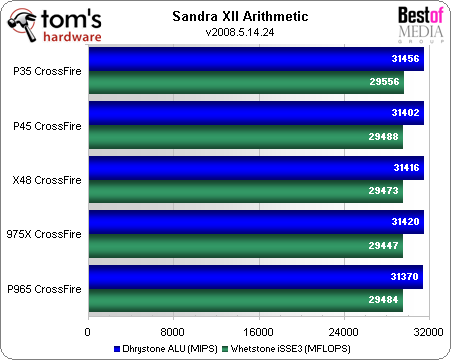
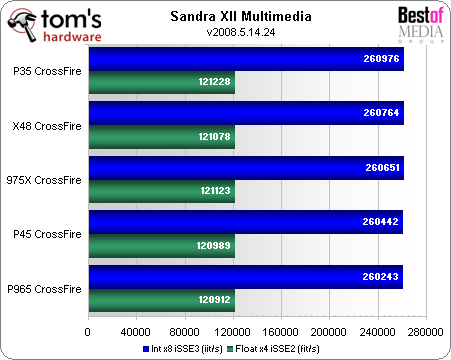
With no discernible difference in CPU performance, it’s time to see what northbridge overclocking means in terms of memory performance. For that, we used Sandra’s memory bandwidth benchmark.
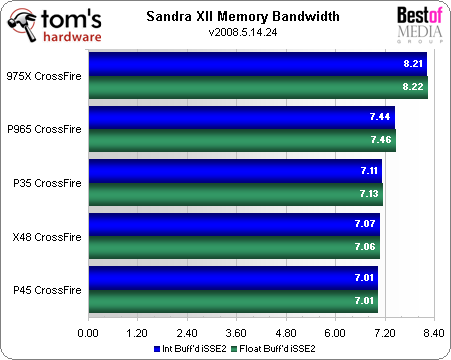
The farther a chipset was pushed beyond normal operating parameters, the more memory bandwidth the CPU had—almost certainly the result of overclocking the chipset’s memory controller.
But not every benchmark is affected by memory speed. For example, 3DMark Vantage tries to single-out the performance of the graphics processor and CPU. We expect PCI Express bandwidth to take on a far more significant role than memory bandwidth in these tests. For the following charts, we used the P35 Express to examine single graphics card performance in PCI Express 1.1 transfer mode, and the P45 Express to test a single graphics card in PCI Express 2.0 transfer mode.
Get Tom's Hardware's best news and in-depth reviews, straight to your inbox.
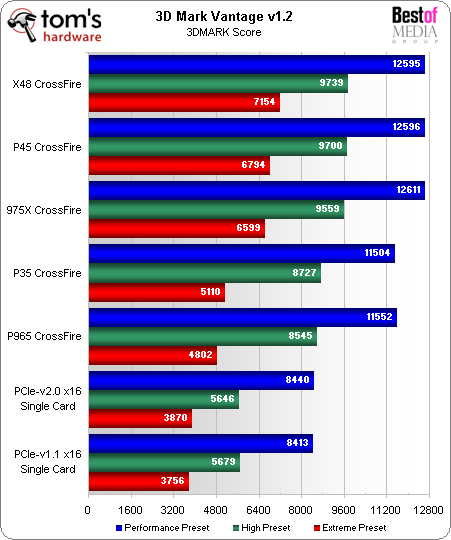
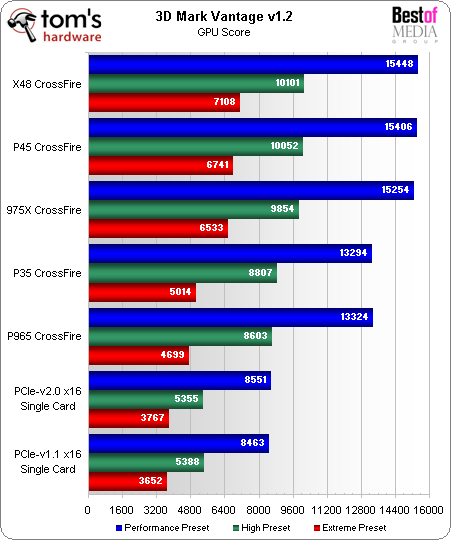

As expected, 3DMark Vantage related its overall score almost directly to its GPU score, with CPU performance relatively constant.
But synthetic scores have little relevance to real-world performance, and now it’s time to see how each motherboard performed in actual games.
Current page: Test Results: Synthetics
Prev Page Test Settings Next Page Test Results: Crysis, GRID, And Supreme Commander-
sparky2010 should've included 1920x resolutions in the last page, as there are a lot of people out there with screens capable of that resolution.. but anyways, all in all a very good and informative article.. but i'm going to settle with a complete makeover when core i7 becomes more available!Reply -
V3NOM yer kinda interesting to see how things have changed with new mobos but it doesnt really have any practical value tbh.Reply -
Crashman V3NOMyer kinda interesting to see how things have changed with new mobos but it doesnt really have any practical value tbh.Reply
It's all about answering the question "Will a second card do the job".
Lots of guys have midrange or better ATI graphics cards, and the question of "upgrade or replace" is constantly being asked. -
outlw6669 @ arkadiReply
Yes the x58 is out.
However, as it can not be paired with a Core 2 CPU and runs DDR3 exclusively, you can not directly compare the results.
In general, I would assume crossfire on the x58 will scale similarly to the x38/48 as they both have the same PCIe configuration. -
Crashman outlw6669Thanks for finally getting this review out!Reply
It was planned for September but kept getting delayed due to tight deadlines on other articles. But when the economy finally went from a slow decline to a nosedive in November, we knew this article had to come out right away. More people are putting new systems on hold and looking for ways to keep their old ones up to current performance standards, and we care about upgraders just as much as system builders.
